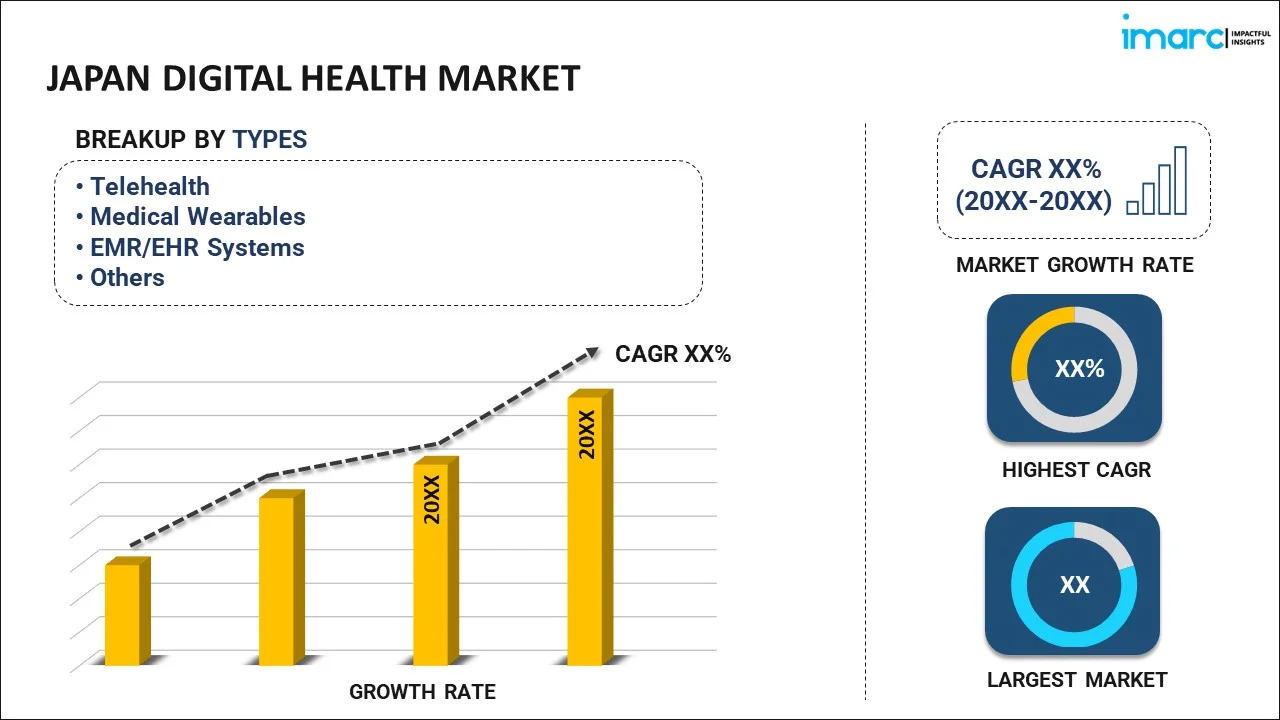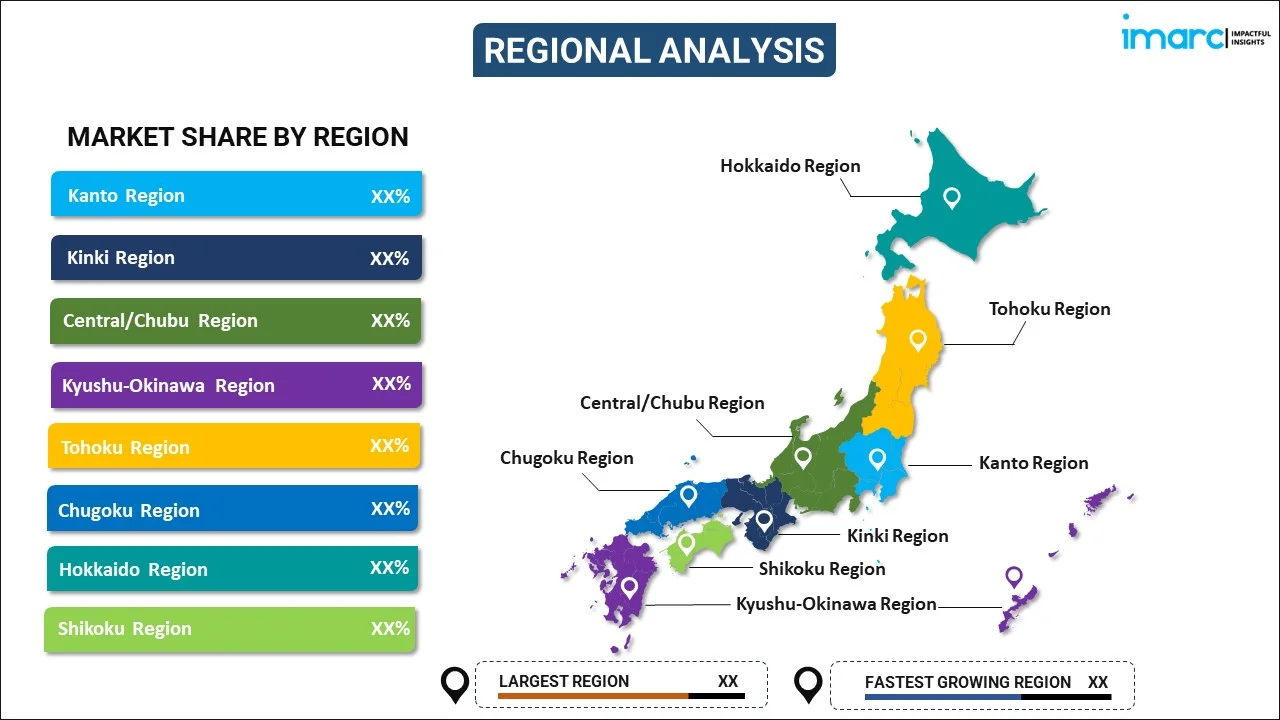
Japan Digital Health Market Report by Type (Telehealth, Medical Wearables, EMR/EHR Systems, Medical Apps, Healthcare Analytics, and Others), Component (Software, Hardware, Service), and Region 2025-2033
Market Overview:
The Japan digital health market size reached USD 29.2 Billion in 2024. Looking forward, IMARC Group expects the market to reach USD 55.8 Billion by 2033, exhibiting a growth rate (CAGR) of 7.5% during 2025-2033. The prevalence of chronic diseases, such as diabetes and heart disorders, ongoing technological advancements across the healthcare industry, and the outbreak of the COVID-19 pandemic across the country represent some of the key factors driving the market.
|
Report Attribute
|
Key Statistics
|
|---|---|
|
Base Year
|
2024
|
|
Forecast Years
|
2025-2033
|
|
Historical Years
|
2019-2024
|
|
Market Size in 2024
|
USD 29.2 Billion |
|
Market Forecast in 2033
|
USD 55.8 Billion |
| Market Growth Rate 2025-2033 | 7.5% |
Digital health refers to the use of digital technologies and data to enhance healthcare delivery and personal wellness. It encompasses various subfields, such as telemedicine, electronic health records, wearable devices, and mobile health applications. Digital health aims to provide more personalized care, making healthcare more efficient and accessible to patients, regardless of their location. The integration of technology in healthcare also enables medical professionals to monitor, diagnose, and treat patients in real time, which can improve outcomes and reduce costs. Furthermore, digital health promotes collaboration between patients and healthcare providers by facilitating communication and information sharing. This allows for a more holistic view of a patient's health and enables more informed decision-making. The trend towards digital health reflects a broader shift in healthcare, emphasizing prevention and patient-centric care, supported by data-driven insights. Digital health is revolutionizing the way healthcare is delivered, promoting better patient engagement, improving accessibility, and offering tools that empower both patients and healthcare providers to manage health more effectively. It's an essential component of modern healthcare, aligning technology and healthcare practices for the betterment of patient care.
Japan Digital Health Market Trends:
Digital health, a rapidly growing sector, is propelled by the increasing global prevalence of chronic diseases, such as diabetes and heart disorders. This necessitates a more streamlined approach to healthcare management; one that digital health can efficiently provide. Simultaneously, ongoing technological advancements, such as AI, big data analytics, and telemedicine, are creating opportunities to enhance patient care, diagnosis, and treatment. Along with this, governments and regulatory bodies are also supporting digital health by enforcing laws and regulations that foster integration and interoperability, reflecting a societal move towards embracing technology in healthcare. In addition, the rise in healthcare costs is pushing the need for cost-effective solutions, and digital health tools can offer affordability without compromising quality. Apart from this, the COVID-19 pandemic has additionally accelerated the adoption of digital health platforms, emphasizing the need for remote patient monitoring and virtual consultations. In confluence with this, consumer demand for personalized and convenient healthcare is also on the rise, with patients seeking more control over their health data and treatment plans. Furthermore, partnerships and collaborations between tech companies and healthcare providers are paving the way for more comprehensive and tailored digital health solutions. Some of the other factors driving the market include the growing penetration of the Internet of Things (IoT), rapid digitization, and inflating disposable income levels of individuals.
Japan Digital Health Market Segmentation:
IMARC Group provides an analysis of the key trends in each segment of the Japan digital health market report, along with forecasts at the country level for 2025-2033. Our report has categorized the market based on type and component.
Type Insights:

- Telehealth
- Medical Wearables
- EMR/EHR Systems
- Medical Apps
- Healthcare Analytics
- Others
The report has provided a detailed breakup and analysis of the market based on the type. This includes telehealth, medical wearables, EMR/EHR systems, medical apps, healthcare analytics, and others.
Component Insights:
- Software
- Hardware
- Service
A detailed breakup and analysis of the market based on the component have also been provided in the report. This includes software, hardware, and service.
Regional Insights:

- Kanto Region
- Kinki Region
- Central/ Chubu Region
- Kyushu-Okinawa Region
- Tohoku Region
- Chugoku Region
- Hokkaido Region
- Shikoku Region
The report has also provided a comprehensive analysis of all the major regional markets, which include Kanto Region, Kinki Region, Central/ Chubu Region, Kyushu-Okinawa Region, Tohoku Region, Chugoku Region, Hokkaido Region, and Shikoku Region.
Competitive Landscape:
The report has also provided a comprehensive analysis of the competitive landscape in the market. Competitive analysis such as market structure, key player positioning, top winning strategies, competitive dashboard, and company evaluation quadrant has been covered in the report. Also, detailed profiles of all major companies have been provided.
Japan Digital Health Market Report Coverage:
| Report Features | Details |
|---|---|
| Base Year of the Analysis | 2024 |
| Historical Period | 2019-2024 |
| Forecast Period | 2025-2033 |
| Units | Billion USD |
| Scope of the Report | Exploration of Historical and Forecast Trends, Industry Catalysts and Challenges, Segment-Wise Historical and Predictive Market Assessment:
|
| Types Covered | Telehealth, Medical Wearables, EMR/EHR Systems, Medical Apps, Healthcare Analytics, Others |
| Components Covered | Software, Hardware, Service |
| Regions Covered | Kanto Region, Kinki Region, Central/ Chubu Region, Kyushu-Okinawa Region, Tohoku Region, Chugoku Region, Hokkaido Region, Shikoku Region |
| Customization Scope | 10% Free Customization |
| Post-Sale Analyst Support | 10-12 Weeks |
| Delivery Format | PDF and Excel through Email (We can also provide the editable version of the report in PPT/Word format on special request) |
Key Questions Answered in This Report:
- How has the Japan digital health market performed so far and how will it perform in the coming years?
- What has been the impact of COVID-19 on the Japan digital health market?
- What is the breakup of the Japan digital health market on the basis of type?
- What is the breakup of the Japan digital health market on the basis of component?
- What are the various stages in the value chain of the Japan digital health market?
- What are the key driving factors and challenges in the Japan digital health?
- What is the structure of the Japan digital health market and who are the key players?
- What is the degree of competition in the Japan digital health market?
Key Benefits for Stakeholders:
- IMARC’s report offers a comprehensive quantitative analysis of various market segments, historical and current market trends, market forecasts, and dynamics of the Japan digital health market from 2019-2033.
- The research study provides the latest information on the market drivers, challenges, and opportunities in the Japan digital health market.
- Porter's five forces analysis assist stakeholders in assessing the impact of new entrants, competitive rivalry, supplier power, buyer power, and the threat of substitution. It helps stakeholders to analyze the level of competition within the Japan digital health industry and its attractiveness.
- Competitive landscape allows stakeholders to understand their competitive environment and provides an insight into the current positions of key players in the market.
Need more help?
- Speak to our experienced analysts for insights on the current market scenarios.
- Include additional segments and countries to customize the report as per your requirement.
- Gain an unparalleled competitive advantage in your domain by understanding how to utilize the report and positively impacting your operations and revenue.
- For further assistance, please connect with our analysts.
 Inquire Before Buying
Inquire Before Buying
 Speak to an Analyst
Speak to an Analyst
 Request Brochure
Request Brochure
 Request Customization
Request Customization




.webp)




.webp)












